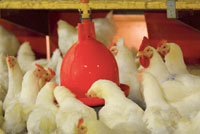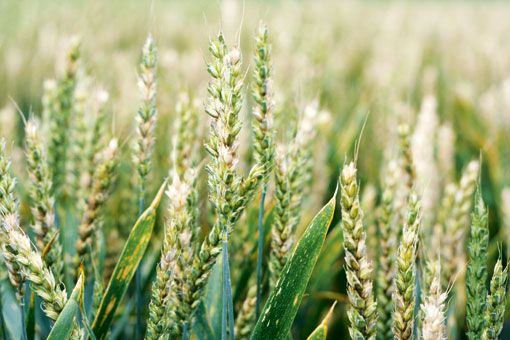Look to tackle mycotoxins to help flock health

Mycotoxins are toxic chemicals produced by specific moulds that infect crops. But while there are around 500 different known types, only a few have been studied extensively for their effects on poultry production.
According to Alltech technical manager Swamy Haladi around 25% of grains produced globally contain some level of mycotoxin, though this figure was much higher in relation to the 2009 US wheat crop, which contained unprecedented levels of vomitoxin.
In the USA, mycotoxins are considered the second most important factor affecting the profitability of poultry production, with only feed costs ranking higher.
Each poultry class has a different level of sensitivity to individual mycotoxins, with turkeys tending to be one of the most susceptible species, says Dr Haladi. In general, poultry can suffer ill health and fail to reach their performance potential if exposed to just 2 parts per million (ppm) of the DON mycotoxin.
 |
|---|
| Swamy Haladi believes around 25% of grains produced globally contain some level of mycotoxin. |
“Outward signs of mycotoxin poisoning in flocks are often difficult to spot, but the toxins affect the birds’ immune system, which can trigger the onset of various diseases,” he explains.
Once mycotoxins have been eaten, the toxins are released, migrating through the blood and eventually reaching the liver and kidneys. They can also cause damage to the intestine and any producer who feels their birds are not achieving weight gain targets should investigate this aspect of feed quality as a matter of priority, advises Dr Haladi.
Purchased feed
The main cause for concern with processed feeds is that mycotoxins can survive the pelleting process, even if temperatures reach as high as 100C.
The first step towards avoiding the problem is to ask your feed supplier or grain merchant about the sampling method they use, and what type of mycotoxin testing is carried out on poultry feedstuffs.
To safeguard against toxic chemicals contaminating feed, each load entering the mill must be thoroughly sampled, with grain taken from multiple positions in the store.
“I suggest that producers should enquire about sampling and testing methods, and ask to see test results, which should show up any mycotoxins present,” says Dr Haladi. “There are various methods of testing for mycotoxins, and some are more accurate than others. Pricing structures also differ widely.”
It is also important to consult an expert, who will ensure that the findings are interpreted correctly. Even if the results show that mycotoxins are below recommended levels, it is still possible for performance losses to be affected.
Top five mycotoxins affecting poultryAflatoxins Ochratoxin A T-2 toxin Vomitoxin (also known as DON) DAS (Diacetoxyscirpenol) |
|---|
Producers who wish to make certain the feed they are offering their birds contains only low levels of mycotoxins, or none at all, can have samples tested independently. There are a number of laboratories around the country that have the equipment to do this.
This advice also applies to poultry producers who are purchasing distillers dried grains (DDG), says Dr Haladi. Grain is routinely tested as part of the ethanol production process, but again, independent testing is preferable.
“Producers should take extra care when buying DDGs,” he warns. “Mycotoxins present in grain entering the manufacturing line are concentrated three-fold by the time they emerge from the process. Therefore, a crop that contains mycotoxins at a level of one part per million, may contain three parts per million when fed to birds.”
 |
|---|
| Wheat with Fusarium. |
Home-grown feed
Mycotoxins thrive in cool, wet weather conditions, especially during July and August, and can build up quickly in grain intended for poultry feed, explains Dr Haladi. Minimum or no-till techniques will give the moulds a greater chance of survival, he adds, making it more likely that the following year’s crop will become infected. Therefore, ploughing is preferable, as long as it fits in with the farm management system.
Crop rotation, using a suitable break crop, will also help to reduce risk, along with holding off harvesting until the grains contain less than 15% moisture. Mould inhibitors can be used to protect crops in storage.
Sampling is also critical and the Home Grown Cereals Authority (HGCA) recommends testing every trailer coming into storage, taking out at least 1kg of grain. Thorough sampling for mycotoxins is essential because distribution is not likely to be uniform within a bulk store.
If composite samples have not been taken at the point of storage, multiple sub-samples from the bulk store should be obtained to build-up a representative aggregate picture, says the HGCA. For official control purposes, one hundred incremental 100g sub-samples are taken from any lot exceeding 20t, though legal limits for fusarium mycotoxins do not currently apply for grain fed to livestock.
“The sampling of feeds and forages for mycotoxin analysis represents the biggest source of variability,” says Dr Haladi. “Therefore, it is critical that anyone going to the effort and expense of performing tests should ensure that the sampling is carried out as accurately as possible.”
However, it is only possible to analyse for indicator mycotoxins, and a negative result does not guarantee the absence of mycotoxins altogether, he stresses. Where one type of mycotoxin is identified, it is highly likely that others are present, since they rarely occur in isolation. Multiple mycotoxins can also act together, causing even greater harm to the birds once ingested.
Mycotoxins can also be masked, he adds. This occurs when the mycotoxin is joined to another molecule, such as glucose or sugar. Masked mycotoxins are still toxic to birds and are undetectable using conventional methods of analysis. This situation may result in mycotoxin levels being underestimated.
Testing methods
There are two main testing methods, one of which is ELISA (enzyme linked immunosorbent assay), a test that usually produces results within a couple of hours. Large feed mills often use this method, but there have been cases where samples given a negative result following an ELISA test have later proved to contain mycotoxins. In cases where there is any doubt, the more stringent HPLC (high pressure liquid chromatography) test should be requested.
Weather risk
Compounders have suggested that, when the risk of mycotoxins is high in UK wheat during wet summers, it is safer to use imported wheat, even though this is bad in terms of food miles. Concerns have also been raised over reports of high levels of contamination among organic crops, though the Soil Association says these claims are unproven.
